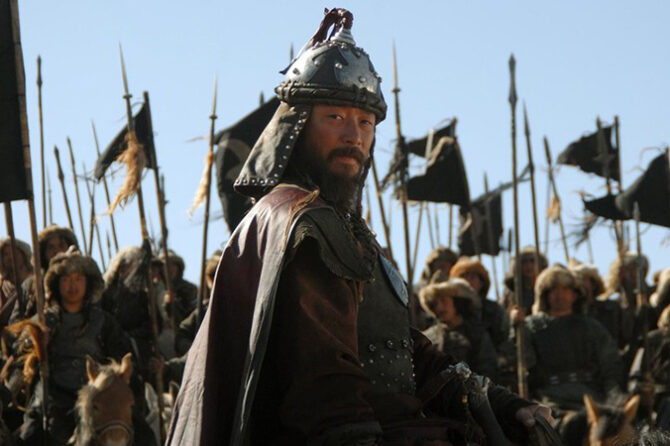
If the lions want war
We gon’ fight until the battle ends
If the tigers come running
We gon’ fight them to the bloody end
When the elephants come
They gon’ bow to my brethren
Lock ’em in a cage
Parade them to the lion’s den……
As someone who cherishes the invigorating power of music, I’ve found that starting my day with “Morning Motivation Anthems” sets a tone of positivity and determination. These anthems, often orchestral compositions, begin with soft melodies echoing the tranquillity of dawn, gradually building up to a crescendo of triumphant brass and motivating drumbeats. This musical journey mirrors the transition from the calmness of early morning to the bustling energy required to tackle the day’s challenges.
Recently, my quest for new anthems led me to a fascinating discovery on YouTube – “The Wolf Totem” by The Hu, from the movie “The Mongol.” This piece stood out for several reasons, chief among them being its incorporation of Mongolian throat singing, or “Khoomei.” This unique style, originating from Mongolia and parts of Siberia, involves producing multiple pitches simultaneously, creating a sound that is both ancient and otherworldly. The technique reflects the Mongolian people’s deep connection with nature, often imitating the sounds of the environment and animals, particularly birds.
“The Wolf Totem” is more than just a song; it’s an immersive experience. The Hu, a band that has masterfully blended Mongolian traditional music with contemporary rock elements, delivers a powerful and evocative sound in this track. The song starts with the resonant tones of throat singing, gradually layering in traditional instruments like the morin khuur (horsehead fiddle) and the tovshuur (Mongolian lute), alongside electric guitars and drums. The result is a melody that transcends time, paying homage to Mongolian history and culture while resonating with modern listeners.
The accompanying music video vividly portrays the military prowess of Genghis Khan, focusing on the pivotal battle between Temujin (the future Genghis Khan) and Jamukha, who were childhood blood brothers. This decisive conflict determines the ruler of the Mongols, with Temujin emerging victorious and ultimately becoming Genghis Khan. As the founder and first Great Khan (Emperor) of the Mongol Empire, he established what would become the largest contiguous empire in history. The video enhances the song’s impact with scenes set against Mongolia’s rugged landscapes, interspersed with imagery that pays homage to Mongolian traditions and the symbolic wolf. These visuals seamlessly blend the ancient with the modern, transforming “Wolf Totem” into not just a musical piece, but a vivid journey through time and culture.
The Hu, formed in 2016, has brought Mongolian music to the global stage, earning acclaim for their “Hunnu Rock” style, which fuses ancient Mongolian throat singing and traditional instruments with rock music. Their name, a play on the Mongolian word for “human,” reflects their belief in music’s universal connectivity. The band’s music is a testament to their deep cultural roots, drawing heavily from Mongolian folklore, history, and nature.

Their global popularity, bolstered by songs like “Yuve Yuve Yu” and “Wolf Totem” and their debut album “The Gereg,” has turned them into cultural ambassadors. Their work not only entertains but educates listeners about Mongolian culture, showcasing the rich heritage and musical innovation of their homeland.
The thematic content of “Wolf Totem” aligns closely with the portrayal of Genghis Khan in “The Mongol,” directed by Sergei Bodrov. This film, which explores the early life of one of history’s greatest conquerors, is a blend of historical epic and personal narrative. It delves into Genghis Khan’s (Temujin) formative years, capturing his journey from a young boy to a legendary leader. The film’s authentic depiction of the Mongolian landscape and its complex tribal culture, along with its exploration of Temujin’s personal struggles and ambitions, provides a humanizing glimpse into a figure often shrouded in myth and legend.
Genghis Khan’s extraordinary military and political achievements are attributed to his charismatic leadership, military genius, mastery of psychological warfare, and innovative strategies. His legacy, which extends from his organizational skills to his diplomatic prowess, reflects a multifaceted approach to leadership and governance.
In “Wolf Totem” and “The Mongol,” we find a profound reflection of Genghis Khan’s spirit and the enduring legacy of Mongolian culture. These works are not just artistic expressions; they are vessels carrying the rich tapestry of Mongolian history, music, and storytelling to a global audience. Every morning, as I listen to these anthems, I am reminded of the power of music to inspire, educate, and transcend cultural boundaries. It’s a journey that starts with the simple act of pressing play, leading to an exploration of the depths of human history and the unyielding spirit that defines it.
While ‘Wolf Totem’ by The Hu has become my regular Morning Motivation Anthem, their extended version of ‘Sugaan Essena’ has turned into my go-to music during focused work sessions. ‘Sugaan Essena’ is an original track for the action-adventure game Star Wars Jedi: Fallen Order. In this game, the protagonist, Cal Kestis, kicks off his adventure by tuning into this song. Interestingly, the lyrics aren’t in Mongolian but in a unique language developed specifically for Star Wars, in collaboration with the band. This song is not just Cal’s top choice for ship scrapping or engaging in epic galactic gladiator battles; it’s a track that can energize anyone.”
Prahlada N. B
29 November 2023
Chitradurga.

















Prahlada Sir 🎼
This time you have chosen ,
refreshing Mongolian singing style 🤹🤹🏻♀️🎵 🎶.
‘Hu’ singing & ‘Sugaan Essena’ are both traditional Mongolian styles.
Hu singing also called ‘ long singing ‘ , is characterised by slow melodious tempo with extended vocalisations , evoking deep emotions ;
Sugaan Essena, on the other hand, allows singers to produce multiple pitches, simultaneously, so as to evoke & resemble sounds of animals in nature .
While Mongolian singing may not directly relate to Genghis Khan’s legacy , it definitely reflects & celebrates Mongolian culture & heritage, which was deeply influenced by the great Mongol leader.
It is said that Mongolian unique singing style has originated from sounds made by herdsmen, imitating the sounds of animals, while grazing their livestock.
It has evolved over the years to become a distinct captivating singing pattern ….
Replyresonating with audience worldwide…..🎧🎤 🎼